Product Development Process
The almost infinite amount of products available today can make many believe that every idea turns into a successful product. However, in 1982 Booz, Allen, and Hamilton (BAH) stated that “for every seven new product ideas generated, only one succeeds.”
There are more failed new products, not because those ideas lacked what it takes to succeed, but they weren’t put through the necessary agile product development process to ensure their success. Developing a new product is both an exciting and challenging endeavor.
In this article, you’ll learn the development models companies apply, the stages of product development, critical tips and resources, and the benefits of applying the product development process.
What is the Product Development Process?
The product development process refers to the entire process that a business goes through to turn a product concept into a marketable good or service. It involves all the actions involved in delivering a new product or improving an existing product for customers.
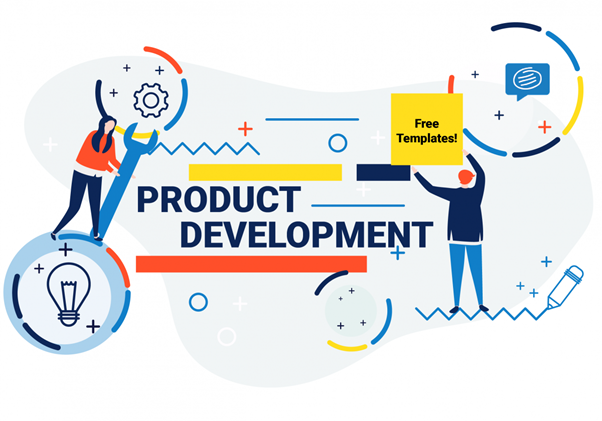
Product development starts with identifying a market need (ideation and concept generation), creating a solution, developing a product, product roadmapping, and marketing the developed product to the target customer.
Attention should be paid to the product development process because it is ultimately responsible for the success or failure of the company’s product. The product idea may be one of a kind, but the business strategy determines whether a successful product hits the market.
The History of Product Development Processes
The formalization of management processes in the 1990s started the evolution of product development. In the 1990s, companies like Ford, AT&T, and General Electric started working on newer, more efficient ways to evolve their product development activities.
At the same time, many other companies were looking for methods of revamping their manufacturing and business processes. With the new approach, they found three truths:
1. Projects are completed faster when they have less going on at one time.
2. Relieving bottlenecks is critical to improving time-to-market benefits.
3. Improving processes by decreasing variation and waste allows for more creativity and better development.
Further, once companies learned that they should take and plan all of their development projects collectively, they could develop according to strategic priorities and stop falling behind in deadlines.
Because of the uniqueness of every product, it is nigh impossible to have two product development processes that are precisely the same. However, they share similar development processes.
These processes can be summarized into the seven stages of the product development process and can help a business get started on its journey of creating a successful product.
The Seven Stages of the Product Development Process
The product development process is broken down into stages to better organize and break individual deliverables into smaller tasks. As such, we have seven (or eight in the case of the new product development process) stages involved in agile product development.
Depending on the product and the business, these seven stages of development may overlap. However, they often begin sequentially and are interdependent on each other. As such, companies would create development teams to handle the seven stages, which are;
1. Idea Generation
Idea generation or ideation and concept generation is the first stage in the development cycle. It is the systematic search for new-product ideas and concepts. The goal of ideation and concept generation is to develop new product concepts that meet a market need.
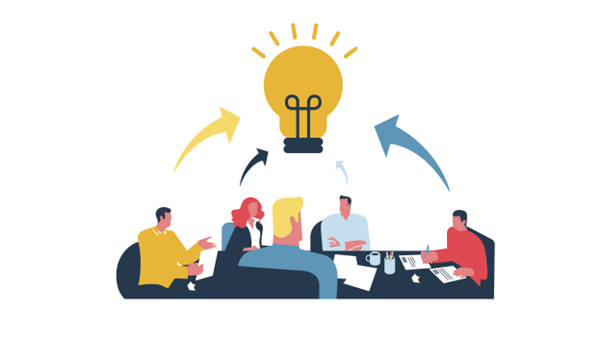
The process of concept development can involve discussing with a development team, market research, and customer feedback. After product concepts have been generated, the next stage, idea screening, comes next.
Idea screening is done to reduce the number of product concepts to ideas that align with the company’s customer value and financial goals. In addition, idea screening will reveal product concepts with poor marketability, thus reducing the chance of failure.
2. Research and Concept Validation
Very often, after getting a product concept, businesses rush into development. In the end, they waste money, time, or effort on an idea that is not marketable. A business strategy and product research will prevent product failure. These companies use proof of concept to determine whether a product idea can make it to commercialization.

Because the product you are creating will be used by customers, they are an important part of the concept validation. Therefore, a concept test should be conducted through online surveys or physical surveys from the target market. It is crucial to determine the product-market fit early in development to avoid wasting time and resources on an idea.
A proof of concept will often include the financials of the project – implementation cost, time of development, product-market fit, time to market – and the revenue it could potentially bring in. Ideas that pass the proof of concept are ready to be developed.
3. Business Plan
Before entering the cost-intense stages of the development cycle, it is important to have a business plan because the economic parameters of a product launch are significant tools in creating an agile product. Ideas that make it to this stage have passed the proof of concept and the required product-market fit.
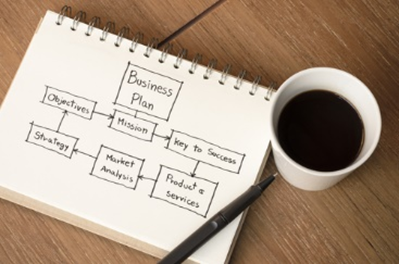
Businesses need a well-defined plan to articulate a strategy for starting development. It also provides insight on steps to be taken, resources required for achieving your business goals. Finally, a business plan makes roadmapping and tracking timelines for anticipated results possible.
4. Prototyping
In prototyping, a design team develops experimental models of the proposed solution. Then, teams build prototypes of varying degrees of fidelity for beta testing on the users. Prototypes let development teams refine and validate their designs until an agile product is developed.
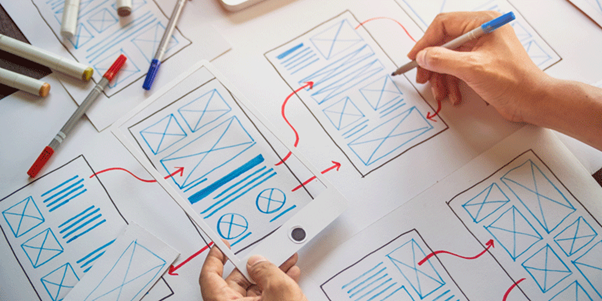
5. Product Development/Product Design
When the prototype is ready, along with the business plan and pricing strategy, management teams then write the technical specifications associated with the product. This stage involves turning the prototype into a marketable product.

This is done by integrating the results of the feasibility analyses and feedback from the beta testing into the product. Help can be sought from the senior management team to sort out the technicalities of the product and prepare for launch.
6. Test Marketing
Test marketing or market testing differs from beta testing in that the finalized product is being evaluated, not the prototype product. The goal of test marketing is to validate the entire product concept.

In finalizing product, a random sample of your target market is offered the product. Market testing is important to get early customer feedback and identify parts of the product that can be improved before a full-scale launch.
To learn more on market and distribution, check out our definitive guide What is Market Research and Why is it Important for Your Business?
7. Commercialization and Launch
This is the final step of the product development process. With the information gathered during the test marketing process, the management team may launch the product. The process of introducing a product to the market is known as commercialization.
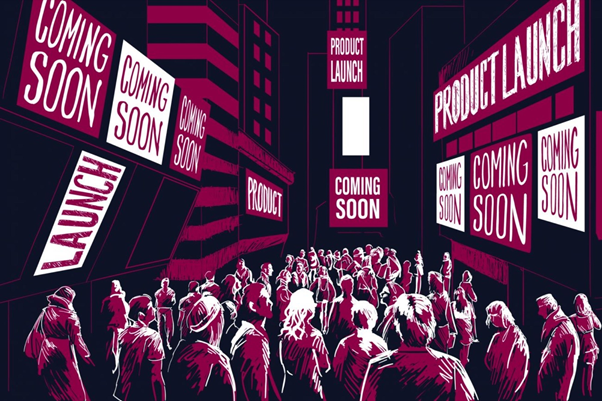
A product launch involves a business’s planned, coordinated efforts involved in publicizing, marketing, and making a new product available for purchase. A product launch can either be soft or hard.
Soft Launch: Often referred to as soft opening, a soft launch involves releasing a product to a specific audience or only to a limited area. Products are released in this manner to evaluate their performance and get early feedback about the product. It also affords the company an extra level of testing where identified problems can be fixed, unnecessary features removed, and new ones added. The soft launch comes before a finished product is released.
Hard Launch:. refers to when a finished product is released in its entirety or as its producer intended it to be, and it’s usually associated with a relatively high level of buzz surrounding the launch, like a new iPhone release. As a result, there is little to no room for modifying the product or adding and removing extra features (software product is an exception). Finished products are usually launched using this approach. The process is carried out with maximum publicity and excitement to grab customers’ attention to boost sales.
Check out our definitive guide to Product Launch | A Success-Driven Strategy page to learn more about how to go about a product launch.
The Four P’s of Marketing
Marketing is one of the most important stages of agile product development. The four essential factors of a marketing strategy are also known as the 4 Ps of marketing strategy or marketing mix. These four factors are essential for marketing a product or service to the public.
1. Product
Product refers to a good or service that a company offers to customers. In creating a product, the business owner must understand the problem it is trying to solve; this will give the business a place in the market.
To get this element of marketing mix right, a business must answer; what is the product? What is the target market of the product/service? and what separates the products from other alternatives in the market?
The type of product also influences the price tag placed on it, the market where the product can be sold, and the best channels a business can utilize to promote it in the marketplace.
2. Price
Price is the attached value a business places on its product or services. While it may seem pretty straightforward, coming up with the ideal price can be challenging. The ideal price should garner the most amount of sales at the same time drive the most profit.
As such, the goal of marketers should be to link the price to the product’s real and its value proposition while considering the supply costs, seasonal discounts, and competitors’ prices. Products are usually priced based on their value proposition.
The business must also determine when and if discounting is appropriate. Occasional discounting can be instrumental in drawing in more customers. However, when wrongly done, it can give the impression that the product is less exclusive compared to when it is was priced higher.
3. Place
Place is simply another word for location. There is a common saying that marketing is all about location. In choosing a place, a business is simply trying to sell their product and how to deliver the product to the market.
The location of a product can mean the stores in which it can be found or its placement on a specific store’s display. In addition, these stores can now be found online on websites or social media platforms.
For a product to be successful, it has to be located where its target market is. So, as much as possible, the business should bring the products as close as possible to the customers. The easier the access to the products, the more the customers are likely to buy.
4. Promotion
Advertising, public relations, and promotional strategy are the main components of promotion. For example, a business employs promotion to show the consumers why they need their product and why the product is worth its price tag.
Placement and promotion are often used together, even more so, with the rise of digitalization and e-commerce. For example, a product can appear on a company’s website or social media with targeted ads for the product.
To maximize the power of promotion, a business can answer the following questions;
§ What are the most used channels your target market uses to consume information?
§ When are the best periods for promoting your product?
§ Is your product affected by seasons?
§ What kind of message tends to be more effective when promoting your solutions?
§ How do your competitors plan and carry out their promotions?
To learn how to strategically place your product on the market, check out our definitive guide on Market Segmentation
The New Product Development
New Product Development (NPD) is basically the same as product development but applies only to new products. New products and services are created to fill a consumer demand or an opportunity in the marketplace. The NPD adds evaluation as the eighth product development phase and new product strategy in the nine product development processes.
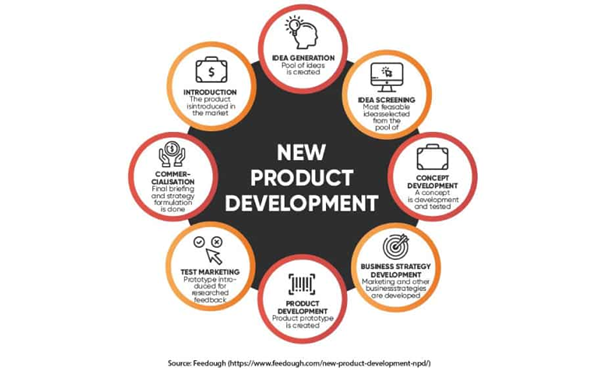
Evaluation is done after commercialization to monitor the progress of a new product offering in the market. In addition, businesses use evaluation to evaluate the product’s performance in comparison to its set organizational goals.
The new product strategy is the first development phase of building an agile product in the nine stages process. In this development phase, the business clearly defines its goals and objectives for the new product.
Models of Product Development
According to urban legends, between 70 and 90% of new products fail in the market.
1. Booz, Allen, and Hamilton Model (BAH Model)
The Booz, Allen, and Hamilton model, otherwise known as the BAH model or Hamilton Bah model, is one of the earliest and most well-known models for new product development. Booz, Allen, and Hamilton stated in 1982 that “for every seven new product ideas generated, only one succeeds.”
The seven processes in the Booz, Allen and Hamilton model are; New product strategy, Idea generation, Screening and evaluation, Business analysis, Development, Testing, Commercialization. The Hamilton BAH mode formed the foundation for every other PD model developed after.
Because the Hamilton BAH model was developed before Rapid prototyping began, the bah model does not consider the need for speed and flexibility in today’s marketplace. This has been accounted for by the integration of prototyping into the development cycle.
2. The State-Gate Model
This model is also known as the Phase-Gate model. It was proposed in the 1980s as a new tool for managing new products development processes. This approach involves dividing up the development phase of new products into a funnel system.
The eight phases in this model are; idea generation, idea screening, concept test, business case analysis, product development/concept development, test market, commercialization, and launch.
After each development phase is completed, it is sent to the management team for approval before another development phase can begin. Some companies have adopted a system where more than one development phase can happen simultaneously. The State-Gate Model was mainly applied to the consumers’ goods industry like the food and beverage sector.
The developer of this model, Robert G. Cooper, boasted that the State-Gate model can lead to a 30% development cycle reduction time. In addition, companies that adopt this model have been reported to record improved teamwork, success rates, earlier detection of failure, a better launch.
3. Lean Start-up Approach
This model is applied by businesses that seek to eliminate wasteful practices and increase value-producing practices during the earliest phases of production. New businesses use this method to increase their chance of success without requiring large amounts of capital, elaborate business plans, or a perfect product.
Customer feedback is a crucial part of the development process. Customer feedback ensures that the business does not design a product that the customers do not want. By getting customer feedback, a business can set its minimum viable product (MVP). Companies that use this approach cannot afford to have their entire capital investment depend on the success of a single product.
In his book, The Lean Startup, entrepreneur Eric Ries, defines a minimum viable product (MVP) as the “version of a new product which allows a team to collect the maximum amount of validated learning about customers with the least effort.”
These companies will release minimum viable product (MVP) into the market, get customer feedback. Then they move to upgrade the product to meet the needs of its target market. The lean start-up approach can also be beneficial in launching new products or services in environments with high uncertainty.
4. The IDEO Process
This model was adopted by IDEO, a design and consulting firm. This model is famous for being a “human-centered design process.”
The steps in the IDEO process can be summarized into;
§ Observing and understanding the market, customer, the technology, and the limitations of the problem
§ Researching and synthesizing the information collected at the first step
§ Visualizing the new customers using the product
§ Create a prototype, evaluate and improve the concept;
§ Implement the design changes. The implementation may take more time because it usually requires more technologically advanced procedures
Tips and Resources for the Product Development
Because of the uniqueness of every product and business, product development processes cannot be the same across the board. However, these tips and resources can be applied in the development cycle to improve product development.
1. Idea Generation
An agile product starts with a great product idea. In developing a product, remain open to ideas generated from anywhere within the organization’s workforce. In addition, no idea or opportunity should be left unchecked.
Keep room open for ideas generated from any team member because they can stumble upon an idea for a great product in a spark of inspiration. Successful companies are built on innovation and design thinking. When team members are able to share their ideas generated, they will feel more fulfilled and motivated.
2. Choose a Methodology
The level of success a business can achieve can directly be linked to the methodology or number. Your methodology should include pricing strategy, market strategy, development strategy, business strategy, and business continuity.
In addition to choosing strategies, your business should develop a framework to ensure that they are utilized by the different crossfunctional teams. Following the framework is crucial in getting the most out of the strategies and developing an agile product.
3. Understand the Customer
The goal of the product development process is to create an agile product that solves a problem and meets the satisfaction of a target customer. Such a product cannot be created without first understanding the people who would use the product.
Implementing the ideas generated and an understanding of the target market, the business should create a product that meets their required specification. If the target customer is not involved in the process, the product can be a misfit in the market.
Having an understanding of the customer cuts across every stage of the product development process. For example, in beta testing, customers should determine functionalities that need to be added or removed from the product. In the marketing stage, it is important to understand the most efficient channels that can be applied to reach the target customer.
4. Communication
Another important tip in the agile product development process is communication. Keeping communication channels open would ensure that expertise and knowledge are easily transferred from person to person across crossfunctional teams, development teams, and throughout the business.
Failure to share information or slow transfer of information between teams can delay the product development process and may even lead to the death of a business.
5. Timelines
While roadmapping is an important component required for a successful product, timelines should be realistic enough for the management team to follow. Product roadmaps should be used to guide the crossfunctional teams in creating efficient working schedules.
When roadmapping is used rightly, they point the crossfunctional teams to the most essential activities in creating an agile product. In addition, it can aid the synchronization of tasks in the development process.
Benefits of Using a Product Development Process
While it is common knowledge that having a development process helps businesses to be more organized in their development cycle, what are the specific benefits of a product development process?
1. Increased Value for Customers
One of the most benefits of a product development process is that it increases the value proposition of a product to the customers. Customers are only willing to trade their money for a product when they consider the value proposition as reasonable. Where the value proposition is overwhelming value, then customers will flock to it, leading to growth in the business.
2. Greater Product Control
It is nigh impossible to end up with a successful product without a well-defined strategy. Therefore, it is important to have a well-structured development process for growth and improvement from concept development until commercialization. In addition, this process might help you in achieving your business goals through planning and control.
3. Improved Performance
There is no assurance that huge capital investment will turn excellent product concepts into marketable finished products. While ideation and concept are important, a well-structured product development process improves the chances of developing a successful product. Mistakes in the product life cycle are earlier identified and rectified before the finished product is released.
4. Reduced Cost
Another important benefit of the process is cost reduction. Minimizing costs gives you the flexibility to lower your prices and win an increased profit margin. A critical look at the development cycle will reveal methods of reducing costs including, simplifying the manufacturing process, using lower-cost materials, or eliminating features that are not desired in the market.
EndNote
Although methods of execution may differ, product development has been the decisive factor in giving businesses a competitive edge in their sectors and keeping others up to date with the changes and trends in the market. To get the best out of PDP, a business will need product managers to act as strategic directors of the development cycle.
As the case may be, these managers or management teams (as the case may be) are responsible for pulling together the crossfunctional team and communicating the goals and plans for the product. In addition, they also oversee the development team’s progress at every stage of the product development process.
